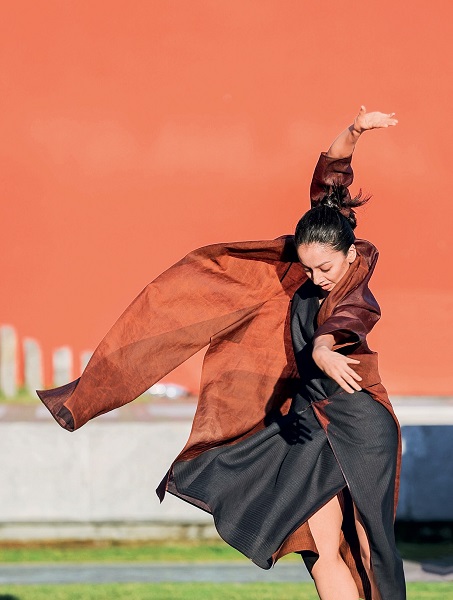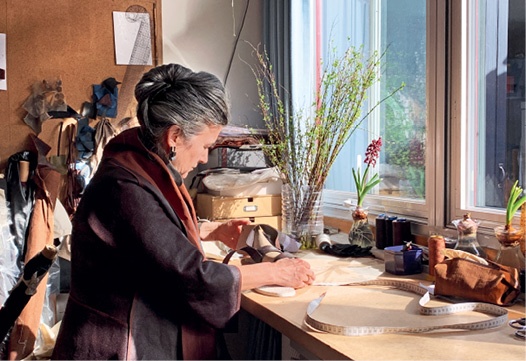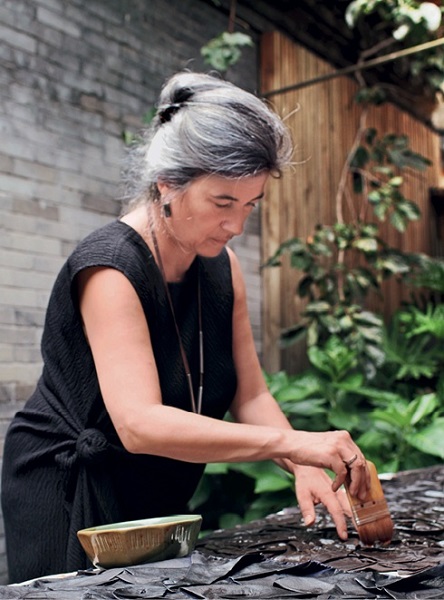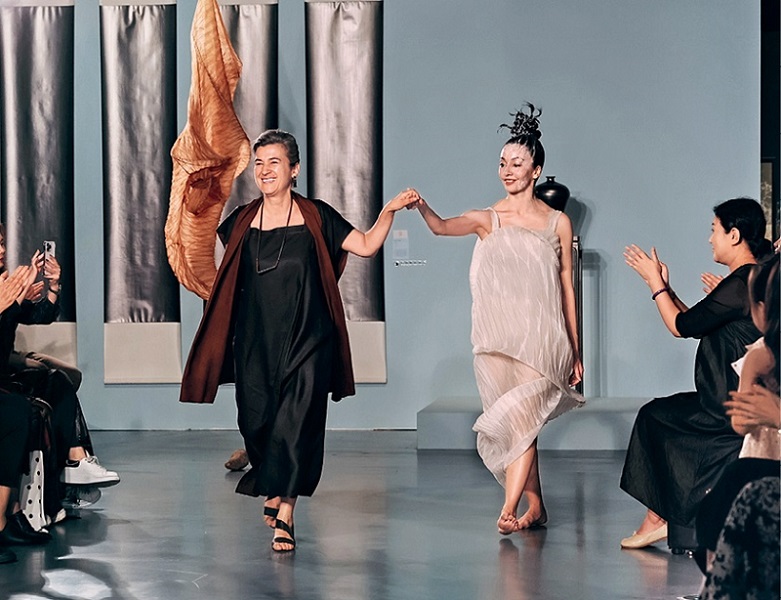
A dancer dressed in Xiangyun silk performs at Rechenberg’s runway show during Beijing Fashion Week in 2020.
Xiangyun silk, which literally translates to “fragrant cloud gauze,” is a traditional Chinese silk fabric that originated in southern China several centuries ago. It is known for being dyed with natural plant-based coloring elements, and is one of the few silk fabrics colored this way. As its dyeing process is greatly affected by weather conditions, the output is limited, and it is therefore regarded to be “as precious as gold” in textiles.
Tucked away in an alley or “hutong,” near Qianmen in Beijing’s Dongcheng District is a tastefully renovated fashion studio specializing in haute couture made primarily from Xiangyun silk. The owner of the studio is Kathrin von Rechenberg, a German designer who has lived in Beijing for 25 years.

Kathrin crafts a design at her studio in Qianmen, Beijing.
Love at First Sight
“Is it really made of silk? How can silk have different colors on two sides? How can it be as light and thin as paper, yet as tough as leather and shimmering like metal? It is so fascinating!” Kathrin still vividly remembered the awe she felt when she first encountered this fabric.
The first time Kathrin, from Munich, Germany, saw this Chinese fabric was in Paris, the fashion capital of the world. In 1995, while studying at Paris’ distinguished fashion and design school, the Ecole de la Chambre Syndicale de la Couture Parisienne, she met a Chinese designer dressed in Xiangyun silk clothes.
“I had worked at haute couture houses like Chanel and Dior, and I had seen many high-end and beautiful fabrics, but I had never come across anything like Xiangyun silk – so full of vitality,” she recalled. “It felt calm yet dynamic, and I felt drawn to it immediately.” From that moment on, she began to develop what seemed a destined bond with this mysterious material.
“I heard it was a traditional fabric from China, 100 percent dyed with natural pigments and handmade. It’s incredibly eco-friendly, and this connection to nature imparts it with such lively character. I knew I had to find it,” Kathrin recalled. And she wasted no time. In 2000, driven by her fascination with this silk, she traveled alone to China in search of its roots, a journey that has lasted 25 years to date.
In Beijing, she met Zhang Xiangyun, who would later become her husband. “Back then, very few people knew about Xiangyun silk,” Zhang said, adding that “I helped her collect information while working to earn a living. After a long search, we finally got a lead at Ruifuxiang, a time-honored silk brand in Beijing. We were told the fabric originated in Shunde City, Guangdong Province. We contacted the producers right away and went to see them.”
Zhang said, “That’s when we learned just how complex the traditional production process is. It involves 36 procedures of 14 steps and requires sunlight, Dioscorea cirrhosa Lour (dye root), local river mud, and skilled craftsmanship. In a sense, this handicraft is largely dependent on natural surroundings and climate.”
Having finally found the fabric she had long sought, Kathrin returned to Beijing and went on to establish her namesake fashion label, Rechenberg, whose garments are made mainly of Xiangyun silk and crafted to the standards of Parisian haute couture.

Kathrin dyes textile with natural dyes.
When East Meets West
For the past 25 years, Kathrin has been dedicated to exploring better ways to demonstrate the charm of this ancient and mysterious fabric. True to her German roots, she takes a meticulous and uncompromising approach to her craft, especially when it comes to fabrics. To achieve the desired results, she travels almost every year to Shunde to consult with local artisans and dye the cloth personally.
In Kathrin’s own words, it is a “challenging yet magical journey.” The entire dyeing process is completed by hand. After being soaked in dye root bath, the silk is laid flat to dry in the sun in temperatures of around 40 degrees Celsius. To achieve the ideal color, the steps of soaking and drying are often repeated more than 30 times. Next comes the application of river mud, which is evenly spread across the surface of the silk. The natural iron content in the mud reacts with the tannin in the dye, turning one side of the fabric into lustrous black.
“Xiangyun silk is a precious gift from nature. The more I work with it, the more I get obsessed,” said Kathrin. “What truly matters to me is the fabric itself, and how we show respect, not just for the material, but for the artisans who created it and the natural world that makes it possible.”
Moreover, this unique silk offers Kathrin a new perspective about dressmaking. She believes Xiangyun silk is a fabric that has its own personality and soul. The dyeing and printing techniques passed down over the past 600 years have imbued it with a unique cultural identity. In her eyes, designing is more about getting to know the fabric’s personality and helping it become a one-of-a-kind garment, rather than showing off the designer’s skills.
“Unlike in the West, where structured shapes and sharp tailoring are often emphasized,” she explained with a smile, “Traditional Eastern clothing values cultural meaning and harmony with the fabric. I really admire the way Chinese people in the Song Dynasty made clothes, minimizing cutting, and designing clothes based on the characteristics of the specific piece of fabric they are working with.” After personally experiencing the arduous process of making Xiangyun silk, she now tries her best to prevent wastage in cutting fabric, taking care to not waste even a small scrap. Her design reflects the Chinese philosophy of harmony between humanity and nature.
Kathrin’s vision of revering nature, respecting the fabric, and returning to simplicity has resonated with many. Some world-renowned artists have become loyal clients, and some dancers and singers even seek her out for custom designs for performances. Through her needlework, Xiangyun silk is reaching clients beyond China.
Over the past decade, inspired by Xiangyun silk’s natural dyes, Kathrin has been trying to create plant-based pigments by experimenting with ingredients like pomegranate rinds and indigo root. Through the traditional Chinese technique of tie-dyeing, she not only dyes fabrics yellow and purple, but also creates distinctive patterns. “These natural colors suit Xiangyun silk well, and they give me even more room to create my work,” she explained. At the same time, she feels a great sense of fulfillment for injecting new vitality into this centuries-old textile through her creativity.
In her designs, she has boldly sown together Xiangyun silk and other fabrics like cotton, and linen. “The contrast and harmony between various natural materials can create more layers of visual effects and offer a different wearing experience,” she noted. She hopes that while respecting nature and tradition, such creative attempts of blending traditional handicraft and modern fashion can expand the use of Xiangyun silk for more people to appreciate its beauty.

Kathrin and dancer Amy Grubb take a bow at Rechenberg’s runway show in Shenzhen, June 2023.
Going Global
Having worked with Xiangyun silk for over two decades, Kathrin has also witnessed the transformation of China and its fashion industry.
“When I first came to Beijing and began creating garments with Xiangyun silk, most of my customers were foreigners,” she recalled, adding that “Like me, they had great interest in this Chinese fabric. But at the time, very few Chinese people wore it, perhaps for historical and aesthetic reasons.”
In recent years, as Chinese people’s cultural confidence has grown, so has their love for traditional Chinese styles. Today, Kathrin has more Chinese clients than ever before, and many of them are young people. “The 2008 Beijing Olympics drew the world’s attention to China. In the same year, the traditional craft of making Xiangyun silk was added to the country’s first list of national intangible cultural heritage items. Since then, more and more people are learning about and appreciating this fabric,” she said.
Kathrin finds these changes encouraging and meaningful, because it reflects a return to cultural roots. Sustainability and eco-awareness have become key criteria for customers in choosing clothing material, which Xiangyun silk perfectly fits.
“I feel very lucky, having encountered Xiangyun silk. It has given me so much inspiration and allowed me to continue doing what I love the most. Through my work, I hope I can help people around the world understand and appreciate the beauty of this natural Chinese fabric,” Kathrin enthused.
And she has been delivering on this vision. In China, Kathrin often hosts themed salons surrounding Xiangyun silk in her studio, bringing together a cohort of Chinese and international friends who share a deep appreciation for this handicraft. In Europe, she has introduced this silk to her former colleagues and fellow designers. To better showcase the fabric, she not only organized self-funded fashion shows but also brought her collections to shows during the Berlin Fashion Week and Paris Fashion Week, and sponsored exhibitions at the Chengdu Art Biennale and the Design Museum in London, among others.
“The pursuit of beauty knows no borders,” she emphasized. “Eastern aesthetics aren’t just about appearances or forms; they also value spirits and cultures.” In recognition of her contributions, Kathrin was awarded the title of “Friendship Ambassador for Textile Intangible Cultural Heritage” at the 4th China Textile Intangible Cultural Heritage Conference in 2020.
In April 2024, she was invited to Paris for a cultural event marking the 60th anniversary of diplomatic ties between China and France. “I brought several Xiangyun silk garments with me. I felt deeply honored to represent it on the international stage,” she recalled. “Though having lived in China for 25 years, I still have an insatiable curiosity for the fabric and other aspects of Chinese intangible heritage. I will continue learning and working here, introducing Chinese culture to the world.”